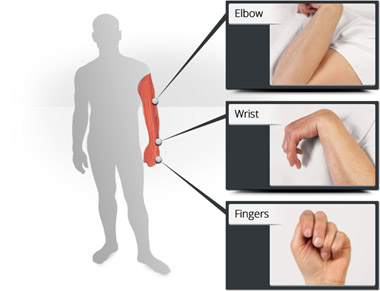What is Spasticity?
Spasticity is defined as a ‘velocity dependant increase in tonic stretch reflex’. To break this down, everyone’s muscles have tone. Tone means how ready a muscle is to contract. Some people have low tone, flaccidity, meaning that muscles aren’t as ready to contract, and some people have high tone, meaning the muscles are almost too ready to contract.
The ‘velocity dependant’ part means that if a muscle is stretched slowly, it can sometimes go through the full range of movement, but if contracted quickly, it will demonstrate spasticity, or a block, to prevent a full stretch. Spasticity is usually caused by damage to nerve pathways within the brain or spinal cord that controls muscle movement.
The degree of spasticity varies from mild muscle stiffness to severe, painful, and uncontrollable muscle spasms. Spasticity can sometimes interfere with rehabilitation in patients with MS, which is why therapists and medics work together to try and prevent spasticity worsening, and developing into a contracture, or a fixed position.

Signs and Symptoms
Signs of Spasticity can include:
- Muscle spasms - when affected muscles stretch, spasticity may cause them to jerk in an uncontrolled way: a spasm. If muscles do this repeatedly, it is known as 'clonus', eg when a foot taps repetitively on the floor. Some people with MS can experience sudden involuntary movements that can make the arms or legs move quickly. These can occur even without the muscle being put on a stretch.
- Hypertonicity - increased muscle tone
- Exaggerated reflexes on testing
- Fixed joints – contractures
- Involuntary crossing of the legs
How is Spasticity Treated?
Pharmaceutical treatment may include medications such as Baclofen, Diazepam, Tizanidine or Clonazepam, which are whole body muscle relaxants. Whereas targeted injections of Botulinum toxin (BOTOX) into muscles with high tone can help to selectively weaken these muscles to improve range of movement and function. This treatment is often used as a gateway of opportunity for rehab in combination with splinting and Physiotherapy.
Physiotherapy treatment can include a stretching programme for the tight muscles, and range of movement exercises to help prevent shortening of muscles. Prevention is definitely better than cure in the case of Spasticity, so start stretches early and add them into your daily routine.
Attached are two useful videos about the management of Spasticity:
https://www.youtube.com/watch?v=vRqKv6YDPog
https://www.youtube.com/watch?v=2L517fXZfTs
Spasticity triggers
It is important to understand what can trigger spasticity to become worse, so you can limit this. Below is a table of common triggers:
| Trigger | Management |
| Extremes of temperature | Keep limbs warm in cold or use fan/frozen drinks to keep cool |
| Bladder problems | Monitor urinary tract infections (UTIs) and see GP for antibiotic treatment if required; drink less irritants eg coffee |
| Bowel problems | Try to keep regular, eat lots of fruit/prunes and use exercise to get things moving |
| Pain | Identify source of pain – liaise with MS nurse/Physio/GP |
| Skin irritation | Monitor skin |
| Infection | Commonly UTIs and in growing toenails - monitor and treat accordingly |
| Stress/anxiety | Find ways to relax yourself, whether that be music, mindfulness or asking family for more help |
| Excessive fatigue | Start a fatigue diary so you can manage your fatigue better; have time without any stimulus in the day eg no TV or sounds |
| Acute illnesses eg catching a bug | Making sure you keep as well as you can, but expecting that even if you have a cold, your spasticity will be effected |
| Night time | Spasms can cause particular problems at night: the 'jerking' can cause you to move causing sleep disturbance. |
Specialist Spasticity management
In Herefordshire, we have a specialist Spasticity clinic at the County Hospital which usually runs once a month, as well as being able to access the West Midlands Rehabilitation centre in Selly Oak. These clinics contain very specialist therapists who carry out a thorough assessment to determine the best course of action, whether that be tweaking medication, targeting spasticity triggers or Botulinum toxin injections. Your Doctor and MS team can refer you to these clinics, if we feel you need to be assessed by them.
Nb some people actually use their tone and spasticity to be able to function, like being able to use rigidity in your legs to stand and walk. So these specialists weigh up the pros and cons to reducing tone, and whether this will impact function positively or actually be detrimental.
